Abe Sada, Victim and Killer
Note: This edition of Terrible People from History covers sexual exploitation, and gets more than a little gory as well. Consider yourself forewarned.
Abe Sada was born in Tokyo in May 1905 to a relatively respectable middle class family. It was a bad time and place to be born a girl. Women wouldn’t receive the vote in Japan until 1946, and Japanese society was still very much in the mentality of their feudal caste system – one where women had a completely subservient role. [1] Sada got a glimpse of the double standards this promoted at an early age. Her eldest brother Shintaro was a notorious womaniser, who frequently embezzled from the family business to fund his drunken outings, but his behaviour was largely tolerated by his parents. On the other hand her elder sister Teruko was punished for “promiscuity” by being sold by their father into indentured service in a licensed brothel (a not uncommon punishment for wayward daughters of the middle classes) where he left her for two years before buying out the rest of her contract.
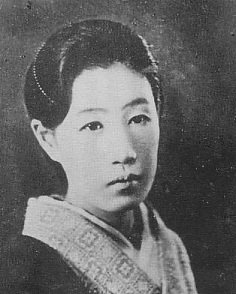
Sada herself was by some distance the youngest child of the Abe family, four of her seven siblings dying in childhood. As such she was very much indulged and spoilt by her parents. She “fell in with a rough crowd”, and at the age of fourteen she was raped by one of these acquaintances. Unsurprisingly she received little support from her parents or from society in general over this, and she fell into a long period of depression that resulted in her dropping out of school. Her family was at the time too poor (thanks to her brother’s antics) to support an aimless teenager, and so they got her a job as a maid to a wealthy family. Sada hated the job, and eventually ran away from the house with a quantity of money and jewellery she stole. This led to her first run-in with the police. By this stage her father had decided that this daughter was as much of a loss to him as the last one. So he contacted a friend in Yokohama, and arranged to have Sada sold into service there in a geisha house.
Geisha entertainment is a tricky concept, especially for foreigners. Essentially a geisha is an escort in the truest sense of the word – a woman who entertains male clients with her presence. While geisha aren’t prostitutes, and aren’t directly selling sex, it’s a mistake to think that sex doesn’t enter into it or that they never sleep with their clients. Sada was left in no illusions about this aspect of her new life by her father’s friend, who raped her himself before delivering her to the geisha house. Sada described her mental condition at the time:
I had made up my mind: “my body is already filthy. I don’t care any more.

Though she was only seventeen, Sada was still too old to ever become a full geisha. Normally geisha training began in the early teens, lasting until the trainees were 20 or 21. On the other hand, most of those girls would have been raised entirely within the geisha system, and so Sada was both more worldly and more educated than them. This made her popular with the clients (as did the fact that her low status meant sex was definitely among what she was offering), and gradually she seems to have regained some confidence and self-direction. Sex became less something that was done to her, and instead became something she herself had an appetite for and enjoyment of.
Around 1926, after three or four years of working as a geisha, Sada contracted syphilis. At the time the disease was incurable but considered controllable, and she was legally permitted to continue working as a geisha as long as she submitted to regular health inspections. Not having to undergo these inspections was one of the advantages the geishas had over shogis, the state-sanctioned prostitutes. The other of course being that a geisha wasn’t explicitly selling sex, though in Sada’s case that didn’t really apply. Sada realised that she could make more money by becoming a shogi without really changing anything, and so at the age of 21 Abe Sada became a full-time prostitute.
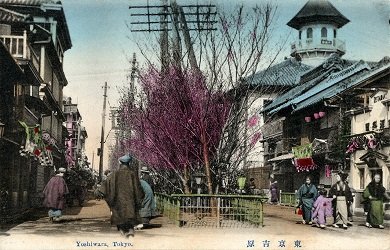
Sada soon discovered that one reason the shogis made more than the lower-ranking geishas was because their lives were much less pleasant. Geishas had the protection of long-held custom. Clients treated them with a certain degree of respect, and they had a measure of control over the encounter. By moving to work in the state-licensed brothels, she had lost that control, and she didn’t take well to it. She struck back at disrespectful clients by stealing from them, and was caught. The punishments she received from this made her decide to get out of the sex trade, and she ran away. She got a job as a waitress under a false name, as she had signed a contract with the brothel. They tracked her down anyway, and she was forced back to complete the remainder of her contract. Once that contract ended in 1932, she was freed from the legal requirement to continue working for the brothel, but she chose to remain in the industry as a shisho – an illegal unlicensed sex worker. She hadn’t enjoyed her time as a waitress, and at least now she could pick her own clients. In 1932 her mother died, and Sada travelled back to Tokyo for the funeral, reuniting and reconciling with her father. She decided to stay there, freelancing in the city’s thriving sex industry. Her father fell ill in January 1934, and Sada nursed him through his final days – a final courtesy for a man who had treated her so shabbily.
Later in 1934, Sada was working in an unlicensed brothel in Tokyo when it was raided by the police. She was arrested along with the other women working there, but as was the usual custom a local fixer bribed the police to get them released. His name was Kasahara Kinnosuke, and he took a fancy to Sada when he met her at the station. He suggested to her that she leave the brothel and become his mistress, which she agreed to. She soon proved to be more than he could handle, however. As he later recounted:
She was really strong, a real powerful one…She wasn’t satisfied unless we did it two, three, or four times a night. To her, it was unacceptable unless I had my hand on her private parts all night long…At first it was great, but after a couple of weeks I got a little exhausted.
His main issue with Sada however was her desire to settle down and finally get some permanence to her life. She tried to persuade him to leave his wife for her, but Kinnosuke refused to do so. Then she suggested they have an open relationship, since he already had his wife, but Kinnosuke made it clear that if she saw any other men, he would stop paying her. With the dynamic of the relationship so clearly exposed, Sada decided to end it – a bitter parting on both sides. Since Kinnosuke’s connections in Tokyo meant that he could easily make life unpleasant for her, she decided to leave Tokyo and head to Nagoya.
Disillusioned by how the financial side had poisoned her relationship with Kinnosuke, Sada once again decided to stop working as a prostitute. Instead she returned to one of her previous jobs, getting a position as a maid in a restaurant. It was through this job that she met Omiya Goro. He was a high school principal with political ambitions, and Sada found herself (possibly for the first time) more romantically than sexually attracted to him. In fact, she later described their sex life as “unsatisfying”, though it was probably a revelation to the quiet and bookish Goro. They kept their relationship a secret, partially due to his plans to run for public office and partially because the restaurant would have fired her for having sex with a customer. “Japanese-style restaurant” was a common cover for brothels, and so the genuine restaurants had to work to maintain their reputations. It was Goro who suggested to Sada a way that she could get some control over her life – open a restaurant of her own.
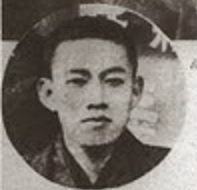
In 1936 Sada returned to Tokyo, in order to take up a position as an apprentice at a restaurant in the Nakano district, a recently absorbed suburb of Tokyo. It was called the Yoshidaya, and it had been opened in 1920 by the then 26-year old Ishida Kichizo. Sada clearly hoped to learn the secret of Kichizo’s success, though that secret actually seems to have been that his wife did most of the management. The 42 year old Kichizo was a notorious womanizer, and Sada soon gave in to his advances. The pair became lovers, and Sada soon became infatuated with Kichizo. On the 23rd of April they met up for what was supposed to be a short dalliance, but which turned into a two week long lovemaking session. Sada later commented that they didn’t stop even while the room was being cleaned around them.
Kichizo had to return to his restaurant on the 8th of May, and Sada immediately began to fall apart. She had developed an obsession with him, and began drinking heavily to try to calm herself down. She even went to see a play, trying to distract herself. The play was called Shinsaku Tsuya Monogatari, “New Tales of the Erotic”, and featured a scene where a geisha killed her lover with a knife to prevent them leaving her. The scene affected her deeply, and started her mind (which was by this pointing heading towards a full on breakdown) down dangerous paths. The next day she went to a hardware store and bought a large kitchen knife.

Kichizo returned on the 11th, and Sada used her new knife as a prop for some erotic roleplay, which Kichizo played along with. Sada also made a joke of threatening his genitals with the knife, asking what she’d need to do to stop him cheating on her. The pair progressed from this to auto-erotic asphyxiation, using the sash from Sada’s kimono to cut off each other’s breath before orgasm. Kichizo was injured when Sada took the play too far, and joked that she shouldn’t stop halfway through strangling him as it hurt so much. On the 18th, Kichizo began talking about his children, and about how important they were to him. As he slept that night, Sada lay awake thinking about the future. She realised that Kichizo wouldn’t leave his wife, as that would mean abandoning his children and business. For the same reason, she doubted he’d agree to a suicide pact. But she couldn’t see how she could bear to be parted from him. So after thinking it all through, she strangled him to death in his sleep.
I cried, saying ‘forgive me’. Ishida uttered a moaning sound once, shook his hands wildly, and then became numb. I let the string go, but my body was shaking uncontrollably. So I gulped down the bottle of sake on the table and made a knot in the string around the centre of Ishida’s throat so he would not revive.
Of course, this is not the logic of a healthy mind. Sada seems to have been in grips of a full on psychotic break that Kichizo had entirely failed to notice, and in fact may have encouraged in order to increase her dependency on him. Her actions after killing him would seem to confirm that dissociation from reality. [2] First she went to sleep beside the corpse, then when she woke she began fondling it. Realising that she’d need to flee, she decided to take Kichizo’s genitals with her. So she severed them with the kitchen knife. With the blood that flowed out, she wrote on his leg “Sada and Ishida Kichizo are alone”. She wrote the same thing on a bedsheet, and she carved her name into his arm. Then, bearing her gory prize, she left.
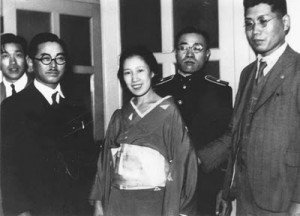
Kichizo’s body was found the next morning, kicking off a nationwide manhunt for Sada and a hysterical reaction in the press. This was partially due to the scandalous details, of course, but was also due to the Japanese folkloric tradition of the “poison woman”, the dangerous woman who kills her lover. Abe Sada was now a real-life poison woman, the ultimate expression of the fears of the time. The last person to see her before she went on the run was Omiya Goro, who she apologised to. He realised later that she was apologising for having destroyed his political ambitions, through his association with her. Numerous mistaken sightings of her occurred around the country over the next few days, with one in a Tokyo shopping district causing a mass stampede and panic. Sada herself was still in the city, staying in a hotel under a false name writing suicide notes. She planned to jump the peak of Mount Ikoma a week after the murder, but she was arrested on the afternoon of May 20th only two days afterwards. The police who arrested her weren’t even looking for Abe Sada, they had simply been doing a routine check and discovered the false name on the hotel register. Sada even told them who she was as soon as they arrived, but they didn’t believe her – until she showed them the severed penis that she still kept with her.
The capture of Abe Sada was a public sensation, and she became an instant “celebrity”. Sada gave a detailed confession, which was published and became a national best-seller. She pleaded guilty at her trial, and admitted to hoping that he would receive the death penalty. The court recognised her diminished mental state, however, and convicted her of murder in the second degree, and of mutilating a corpse. She was sentenced to six years, though a year of this was commuted in 1940 as part of a general amnesty issued by the Emperor to celebrate the 2600th anniversary of the founding of the Japanese empire. [3] She was released in 1941, and initially kept a very low profile. She became the mistress of a man she later referred to only as “Y”, and lived under a fake name. Y knew who she was and kept her secret, but when his friends and family found out they were forced to split up.
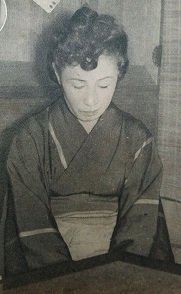
The end of the Second World War brought a new lease of life to Abe Sada, both literally and metaphorically. Literally, as the arrival of penicillin freed her from the shadowy but previously inevitable prospect of death and/or insanity from her syphilis. And metaphorically as Japanese society, and thus its condemnation of her, was utterly shattered. In 1946 Japanese women finally received the vote – a clear marker of the changing times. This new climate was more open to regarding Sada as a victim (both of male exploitation and of her own shattered mind), and she was recast as a feminist hero of a sort. The writer Sakaguchi Ango interviewed her sympathetically for a magazine in 1946, and in 1947 a novel called “The Erotic Confessions of Abe Sada” was released. It claimed to be written by Sada herself, but was actually based on her police confessions and portrayed her as a perverted sadist. In response, Sada wrote her own memoirs (with a much more sympathetic portrayal, of course) and released them. They were a bestseller, and Sada went on tour around Japan for the next several years, appearing on stage as herself in a play based on the incident. In 1952 she settled down in Tokyo, working in a downtown bar as a celebrity attraction. The film historian Donald Richie visited in the 1960s, and described the scene:
[E]very night around ten, Sada Abe would make her entrance…[she] would appear at the head of the stairs, stop, survey the crowd below, and then slowly descend….And as she did so, progressing slowly, indignation was expressed…The men invariably placed their hands over their privates. Fingers squeezed tight, they would then turn and snicker. Above, the descending Sada Abe would mime fury, casting burning glances at those below who squeezed and giggled the more. She slapped the banister in her wrath, and merriment rippled.
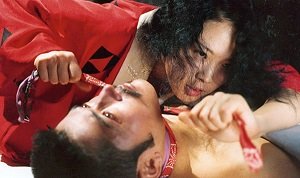
Abe Sada remained a popular subject for books, plays and films throughout the decades that followed and even up to the present day. Two of the most notable and well regarded films about her life were released in the mid 1970s. The first was A Woman Called Sada Abe (literal Japanese title Document:Abe Sada) directed by Tanaka Noboru. It uses the fateful final lovemaking session between Sada and Kichizo as a framing device, but also tells the story of Sada’s life (or a heavily fictionalised version, at least) through flashbacks. One interesting note is the ongoing thread where in the background is all the evidence of Japan’s ongoing military buildup and inevitable slide into World War 2, and the lovers’ complete disinterest in all of it.
Tanaka’s film was erotic, but didn’t cross the line into outright pornography and so was spared the harsh hand of the Japanese censors. The same was not true of the second film, In the Realm of the Senses directed by Oshima Nagisa. Like Tanaka, Oshima plays with the ongoing militarisation of Japan and the pair’s obliviousness to the outside world, but it lacks the flashbacks to Sada’s past. Instead it keeps a tight, almost claustrophobic focus on the two main characters and the power dynamic between them, which is portrayed as both mutual dependence and as a struggle for control of the relationship. The film’s explicit sexual scenes meant that it could not be produced as a Japanese film, so it was officially a “joint Japanese and French production” with the film being shipped to France to be developed and edited. It was still banned outright in many countries, and was only shown in Japan after severe edits were made.
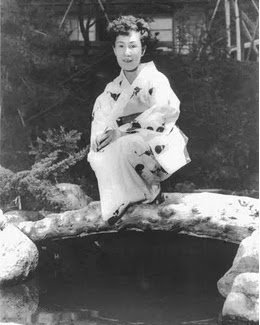
It was Oshima Nagisa who also has the last word on Sada Abe. While he was preparing to film “In the Realm of the Senses”, he decided to find out if she was still alive. She had left the inn in Tokyo where she worked, but eventually he managed to track her down. Sada, in her late sixties at this point, had retreated to the Kansai countryside and become a shaven-headed Buddhist nun. That remains the last recorded sighting of Sada Abe. Presumably she died anonymously in the nunnery. Perhaps at last, her troubled soul found some peace.
Images via wikimedia except where stated.
[1] To give you an idea of how that worked in practice – rape was not considered a crime in medieval Japan. Meanwhile women convicted of petty crimes could be sentenced to indentured service as a prostitute. Not a nice place.
[2] The best-known legal definition of insanity is that contained in England’s “M’Naghten Rules”. Simply put, under those rules since Sada didn’t understand that what she had done was empirically wrong then she could have been found not guilty but insane.
[3] Only an estimate, of course, and based on myth and legend.
